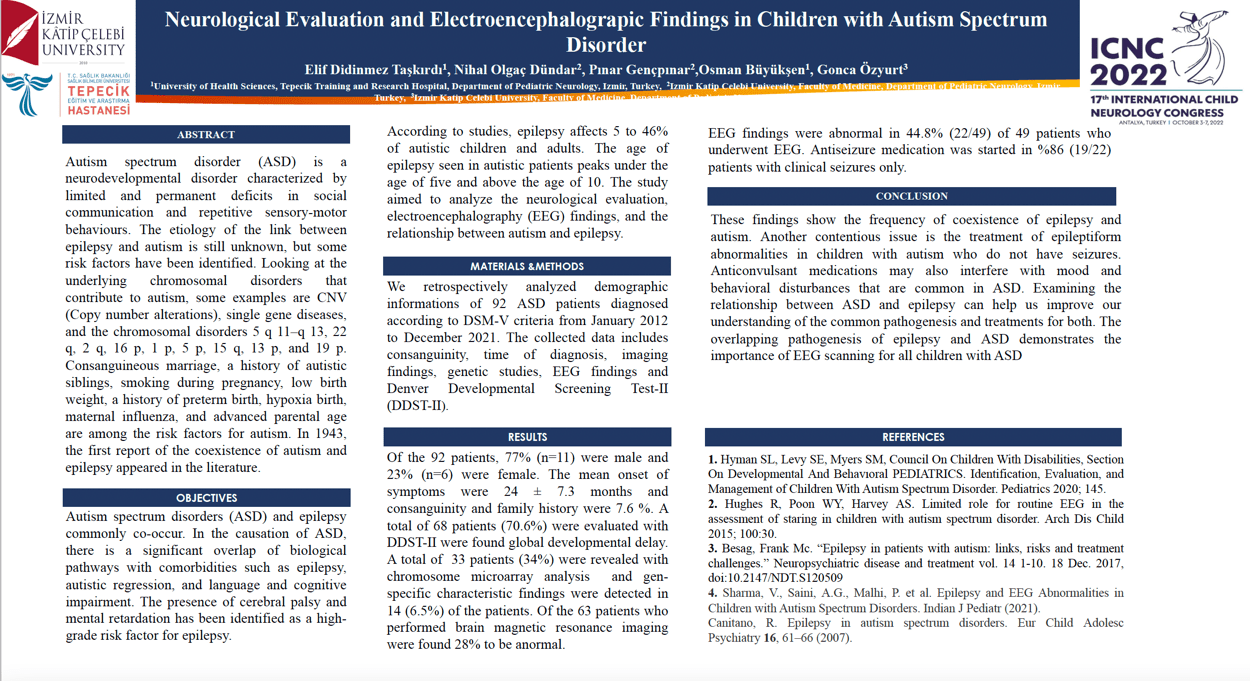Neurological Evaluation and Electroencephalographic Findings in Children with Autism Diagnosis
Elif Didinmez Taşkırdı, Nihal Olgaç Dündar, Pınar Gençpınar, Osman Büyükşen, Gonca Özyurt
Objectives: Autism spectrum disorder (ASD) is a neurodevelopmental disorder characterized by limited deficits in social communication, repetitive sensory-motor behaviours. Epilepsy and ASD commonly co-occur. It was aimed to analyze neurological evaluation, electroencephalographic (EEG) findings and association of epilepsy in children with autism.
Method: We retrospectively analyzed demographic informations of 92 ASD patients diagnosed according to DSM-V criteria from January 2012 to December 2021. The collected data includes consanguinity, time of diagnosis, neuroimaging findings, genetic studies, EEG findings, and Denver Developmental Screening Test-II.
Results: Of the 92 patients, 77% (n=11) were male and 23% (n=6) were female. The mean onset of symptoms were 24 ± 7.3 months and consanguinity and family history were 7.6 %. A total of 68 patients (70.6%) were evaluated with DDST-II were found global developmental delay. A total of 33 patients (34%) were revealed with chromosome microarray analysis and gen-specific characteristic findings were detected in 14 (6.5%) of the patients. Of the 63 patients who performed brain magnetic resonance imaging were found 28% to be abnormal. EEG findings were abnormal in 44.8% (22/49) of 49 patients. EEG was performed in 30 patients without history of seizure. Antiseizure medication was started in %86 (19/22) patients with clinical seizures.
Conclusion: These findings show the frequency of coexistence of epilepsy and autism. Examining the relationship between ASD and epilepsy can help us improve our understanding of the pathogenesis and treatments for both. The overlapping pathogenesis of epilepsy and ASD demonstrates the importance of EEG scanning for all children with ASD.
Keywords: autism, neurodevelopmental disorder, electroencephalograpic, epilepsy
Elif Didinmez Taşkırdı
University of Health Sciences, Tepecik Training and Research Hospital, Department of Pediatric Neurology, Izmir, Turkey
Turkey
Nihal Olgaç Dündar
Izmir Katip Celebi University, Faculty of Medicine, Department of Pediatric Neurology, Izmir, Turkey
Turkey
Pınar Gençpınar
Izmir Katip Celebi University, Faculty of Medicine, Department of Pediatric Neurology, Izmir, Turkey
Turkey
Osman Büyükşen
University of Health Sciences, Tepecik Training and Research Hospital, Department of Pediatric Neurology, Izmir, Turkey
Turkey
Gonca Özyurt
Izmir Katip Celebi University, Faculty of Medicine, Department of Child and Adolescent Psychiatry, Izmir, Turkey
Turkey
Objectives: Autism spectrum disorder (ASD) is a neurodevelopmental disorder characterized by limited deficits in social communication, repetitive sensory-motor behaviours. Epilepsy and ASD commonly co-occur. It was aimed to analyze neurological evaluation, electroencephalographic (EEG) findings and association of epilepsy in children with autism.
Method: We retrospectively analyzed demographic informations of 92 ASD patients diagnosed according to DSM-V criteria from January 2012 to December 2021. The collected data includes consanguinity, time of diagnosis, neuroimaging findings, genetic studies, EEG findings, and Denver Developmental Screening Test-II.
Results: Of the 92 patients, 77% (n=11) were male and 23% (n=6) were female. The mean onset of symptoms were 24 ± 7.3 months and consanguinity and family history were 7.6 %. A total of 68 patients (70.6%) were evaluated with DDST-II were found global developmental delay. A total of 33 patients (34%) were revealed with chromosome microarray analysis and gen-specific characteristic findings were detected in 14 (6.5%) of the patients. Of the 63 patients who performed brain magnetic resonance imaging were found 28% to be abnormal. EEG findings were abnormal in 44.8% (22/49) of 49 patients. EEG was performed in 30 patients without history of seizure. Antiseizure medication was started in %86 (19/22) patients with clinical seizures.
Conclusion: These findings show the frequency of coexistence of epilepsy and autism. Examining the relationship between ASD and epilepsy can help us improve our understanding of the pathogenesis and treatments for both. The overlapping pathogenesis of epilepsy and ASD demonstrates the importance of EEG scanning for all children with ASD.
Keywords: autism, neurodevelopmental disorder, electroencephalograpic, epilepsy
Elif Didinmez Taşkırdı
University of Health Sciences, Tepecik Training and Research Hospital, Department of Pediatric Neurology, Izmir, Turkey
Turkey
Nihal Olgaç Dündar
Izmir Katip Celebi University, Faculty of Medicine, Department of Pediatric Neurology, Izmir, Turkey
Turkey
Pınar Gençpınar
Izmir Katip Celebi University, Faculty of Medicine, Department of Pediatric Neurology, Izmir, Turkey
Turkey
Osman Büyükşen
University of Health Sciences, Tepecik Training and Research Hospital, Department of Pediatric Neurology, Izmir, Turkey
Turkey
Gonca Özyurt
Izmir Katip Celebi University, Faculty of Medicine, Department of Child and Adolescent Psychiatry, Izmir, Turkey
Turkey

Elif Didinmez Taşkırdı
University of Health Sciences, Tepecik Training and Research Hospital, Department of Pediatric Neurology, Izmir, Turkey Turkey
University of Health Sciences, Tepecik Training and Research Hospital, Department of Pediatric Neurology, Izmir, Turkey Turkey